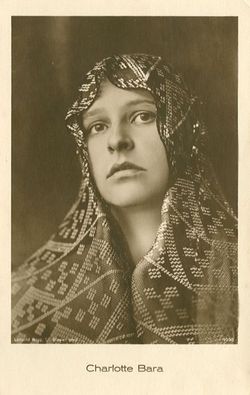Charlotte Bara war die Tochter des deutsch-jüdischen Seidenhändlers Paul Bachrach und seiner Frau Elvira, geb. Bachmann.
Famous German dancer.
https://www.teatrosanmaterno.ch/en/history
Charlotte Bara
The dancer, daughter of a wealthy industrial entrepreneur, was at the height of a brilliant career in the early inter-war period, when the new languages of theatre, stage, and indeed, dance, were finding their full expression, perfectly echoing the innovative spirit of the liveliest artistic avant-gardes of that fervent time.
In 1927 Charlotte Bara decided to found a school of dance, theatre and singing, and consequently, to build a new theatre, primarily to serve the students of the school.
Construction
Charlotte Bara built Teatro San Materno on the site of an old Romanesque church, where she liked to dance within the perimeter hosting the ancient apse.
Teatro San Materno is Weidemeyer's first and most well-known work undertaken in Ascona. Commissioned by Mr. Paul Bachrach for his daughter Charlotte Bara, the Teatro was intended to be a "temple for the artistic expression in the spirit of the dance school." The building is the first chamber- theatre of the modern age in Switzerland. Its multifunctional requirements had an obvious impact on its architecture. Dance, theatre and music performances all had to be hosted, its spaces were needed as a gym for the school, and students were to be able to stay in the furnished rooms located on the top floor of the building. The large terrace was planned for dance exercises in the open. Charlotte Bara danced and organised performances from 1928 to 1958.
Location
Teatro San Materno, built in 1928 by Architect Carl Weidemeyer (Bremen 1882 - Ascona 1976) on the instructions of the father of mime dancer Charlotte Bara (1901-1986) and later sold by Bara herself to the Commune of Ascona, is one of the finest examples of rationalist architecture to be found anywhere in Canton Ticino; in addition, it was the first "chamber" theatre built in Switzerland to modern building standards.
The theatre is an important building in the story of our region. Its rationalist architecture, in marked contrast to the traditional vernacular to be found in the area, makes it a practical example of the culture which developed between the beginning of the Twentieth Century and the Second World War, when Ticino, and Ascona in particular, became a refuge and home to a large colony of thinkers, writers, musicians and artists from both Switzerland and abroad.
The Teatro is located at the foot of Ascona's Monte Verità, between the Commune's cemetery and San Materno castle, the latter being Charlotte Bara's home from 1919.
The above courtesy of the Teatro San Materno Ascona.
Charlotte Bara war die Tochter des deutsch-jüdischen Seidenhändlers Paul Bachrach und seiner Frau Elvira, geb. Bachmann.
Famous German dancer.
https://www.teatrosanmaterno.ch/en/history
Charlotte Bara
The dancer, daughter of a wealthy industrial entrepreneur, was at the height of a brilliant career in the early inter-war period, when the new languages of theatre, stage, and indeed, dance, were finding their full expression, perfectly echoing the innovative spirit of the liveliest artistic avant-gardes of that fervent time.
In 1927 Charlotte Bara decided to found a school of dance, theatre and singing, and consequently, to build a new theatre, primarily to serve the students of the school.
Construction
Charlotte Bara built Teatro San Materno on the site of an old Romanesque church, where she liked to dance within the perimeter hosting the ancient apse.
Teatro San Materno is Weidemeyer's first and most well-known work undertaken in Ascona. Commissioned by Mr. Paul Bachrach for his daughter Charlotte Bara, the Teatro was intended to be a "temple for the artistic expression in the spirit of the dance school." The building is the first chamber- theatre of the modern age in Switzerland. Its multifunctional requirements had an obvious impact on its architecture. Dance, theatre and music performances all had to be hosted, its spaces were needed as a gym for the school, and students were to be able to stay in the furnished rooms located on the top floor of the building. The large terrace was planned for dance exercises in the open. Charlotte Bara danced and organised performances from 1928 to 1958.
Location
Teatro San Materno, built in 1928 by Architect Carl Weidemeyer (Bremen 1882 - Ascona 1976) on the instructions of the father of mime dancer Charlotte Bara (1901-1986) and later sold by Bara herself to the Commune of Ascona, is one of the finest examples of rationalist architecture to be found anywhere in Canton Ticino; in addition, it was the first "chamber" theatre built in Switzerland to modern building standards.
The theatre is an important building in the story of our region. Its rationalist architecture, in marked contrast to the traditional vernacular to be found in the area, makes it a practical example of the culture which developed between the beginning of the Twentieth Century and the Second World War, when Ticino, and Ascona in particular, became a refuge and home to a large colony of thinkers, writers, musicians and artists from both Switzerland and abroad.
The Teatro is located at the foot of Ascona's Monte Verità, between the Commune's cemetery and San Materno castle, the latter being Charlotte Bara's home from 1919.
The above courtesy of the Teatro San Materno Ascona.










